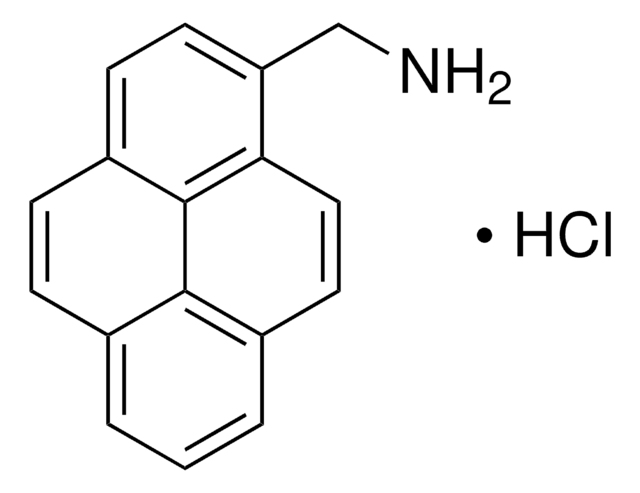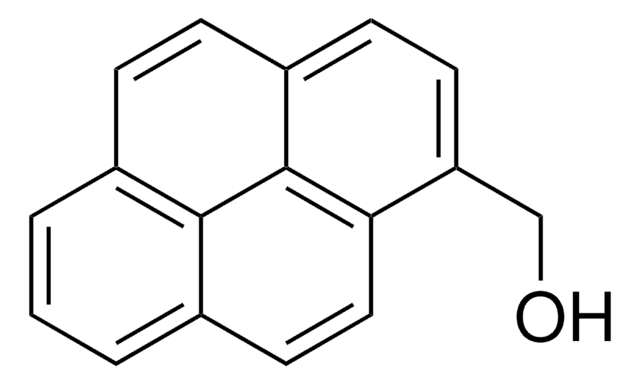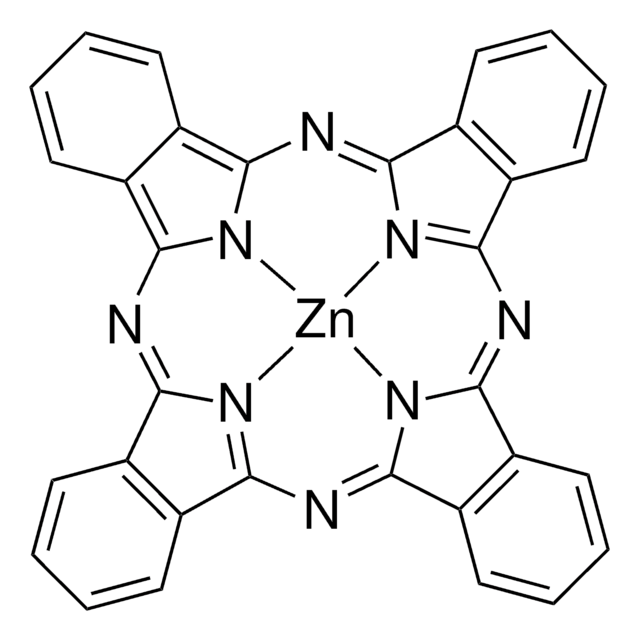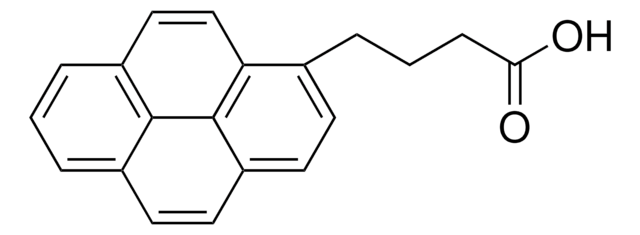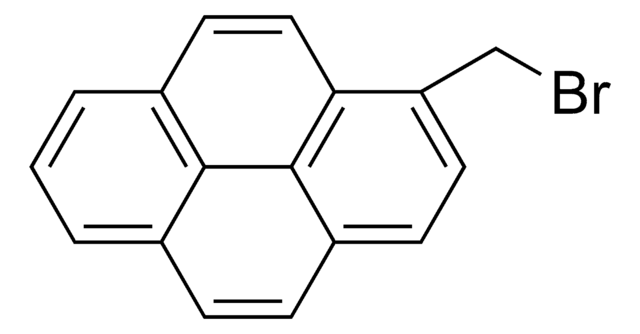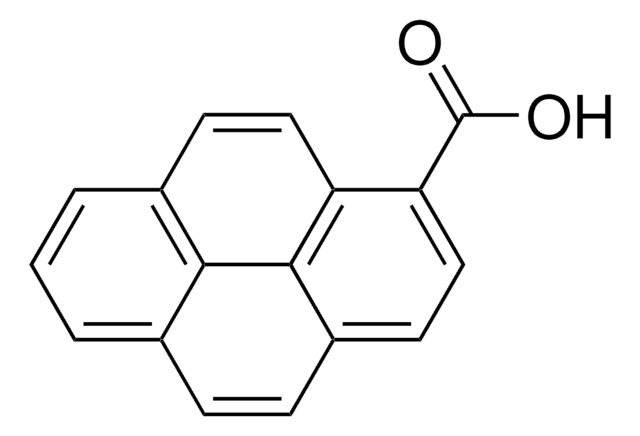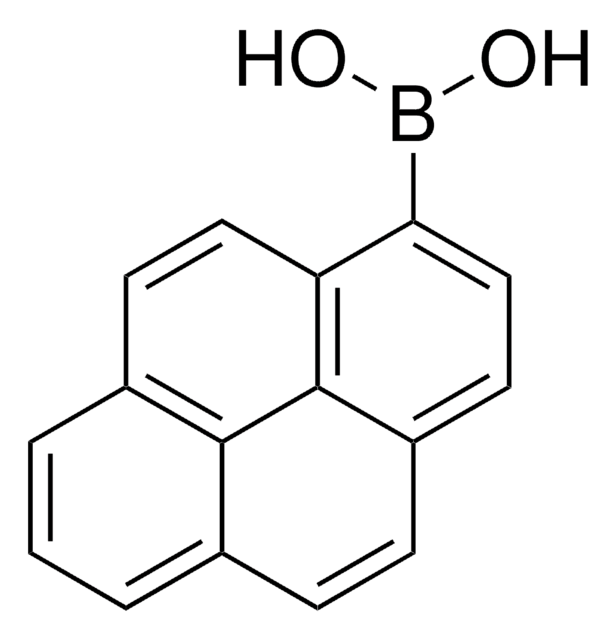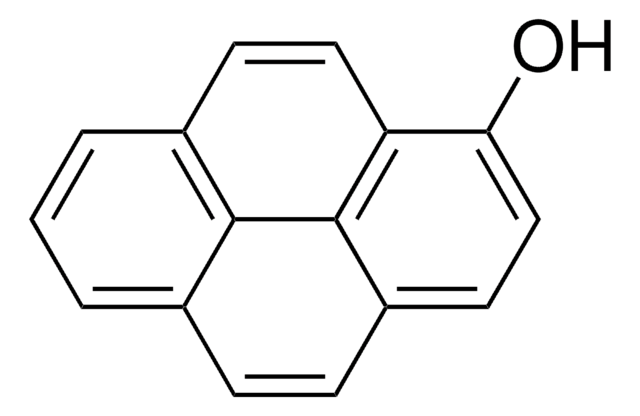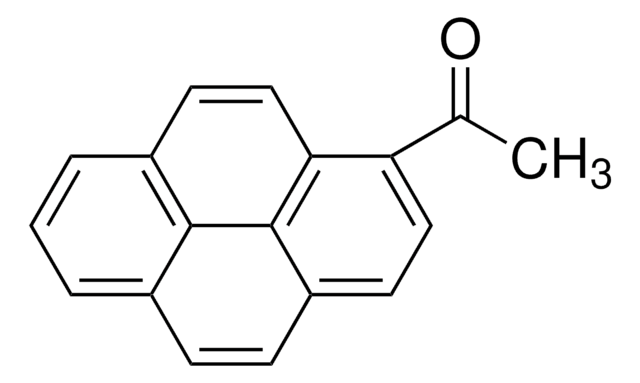399655
1-Pyrenebutanol
99%
Sinonimo/i:
4-(1-Pyrenyl)butanol, 4-(Pyren-1-yl)butan-1-ol
Autenticatiper visualizzare i prezzi riservati alla tua organizzazione & contrattuali
About This Item
Formula empirica (notazione di Hill):
C20H18O
Numero CAS:
Peso molecolare:
274.36
Numero MDL:
Codice UNSPSC:
12352100
ID PubChem:
NACRES:
NA.22
Prodotti consigliati
Livello qualitativo
Saggio
99%
Punto di fusione
80-83 °C (lit.)
Stringa SMILE
OCCCCc1ccc2ccc3cccc4ccc1c2c34
InChI
1S/C20H18O/c21-13-2-1-4-14-7-8-17-10-9-15-5-3-6-16-11-12-18(14)20(17)19(15)16/h3,5-12,21H,1-2,4,13H2
MRENSFROWALQNU-UHFFFAOYSA-N
Categorie correlate
Descrizione generale
1-Pyrenebutanol, an alcohol, is an organic building block. It participates in the polymerization of cyclic esters (lactide, δ-valerolactone and ε-caprolactone).
Applicazioni
1-Pyrenebutanol may be employed in the following studies:
- As a new fluorescent substrate to investigate the allosteric mechanism of P450eryF.
- Preparation of fluorescent polymer based on D,L-lactic acid units end-capped with 1-pyrenebutanol by ring-opening polymerization.
- Synthesis of 1-pyrenebutanol (PB)-labeled poly(lactic acid) (PLA) nanoparticles (NPs).
Avvertenze
Warning
Indicazioni di pericolo
Consigli di prudenza
Classi di pericolo
Eye Irrit. 2 - Skin Irrit. 2 - STOT SE 3
Organi bersaglio
Respiratory system
Codice della classe di stoccaggio
11 - Combustible Solids
Classe di pericolosità dell'acqua (WGK)
WGK 3
Punto d’infiammabilità (°F)
Not applicable
Punto d’infiammabilità (°C)
Not applicable
Dispositivi di protezione individuale
dust mask type N95 (US), Eyeshields, Gloves
Scegli una delle versioni più recenti:
Possiedi già questo prodotto?
I documenti relativi ai prodotti acquistati recentemente sono disponibili nell’Archivio dei documenti.
I clienti hanno visto anche
Cung An Nguyen et al.
European journal of pharmaceutical sciences : official journal of the European Federation for Pharmaceutical Sciences, 20(2), 217-222 (2003-10-11)
A new fluorescent polymer based on D,L-lactic acid units end-capped with 1-pyrenebutanol (PLAP) was synthesized by ring-opening polymerization. PLAP having different molecular weight could be obtained by varying the ratio of D,L-lactide and 1-pyrenebutanol. Fluorescent nanoparticles (NP) were prepared using
Dmitri R Davydov et al.
Biochemical and biophysical research communications, 294(4), 806-812 (2002-06-14)
1-Pyrenebutanol (1-PB) has been used as a new fluorescent substrate for P450eryF to explore the molecular mechanisms of cooperativity. Hydroxylation of 1-PB by P450eryF was detected by both fluorometric and chromatographic assays. Binding was monitored by a substrate-induced low-to-high spin
Poly (L-lactide) Nanoparticles via Ring-Opening Polymerization in Non-aqueous Emulsion.
Dorresteijn R, et al.
Macromolecular Chemistry and Physics, 213(19), 1996-2002 (2012)
Kazuki Fukushima et al.
Biomacromolecules, 18(11), 3834-3843 (2017-10-04)
We developed a biodegradable polycarbonate that demonstrates antithrombogenicity and vascular cell adhesion via organocatalytic ring-opening polymerization of a trimethylene carbonate (TMC) analogue bearing a methoxy group. The monoether-tagged polycarbonate demonstrates a platelet adhesion property that is 93 and 89% lower
Dane Christie et al.
ACS central science, 4(4), 504-511 (2018-05-04)
Nanoscale compositional heterogeneity in block copolymers can impart synergistic property combinations, such as stiffness and toughness. However, until now, there has been no experimental method to locally probe the dynamics at a specific location within these structured materials. Here, this
Il team dei nostri ricercatori vanta grande esperienza in tutte le aree della ricerca quali Life Science, scienza dei materiali, sintesi chimica, cromatografia, discipline analitiche, ecc..
Contatta l'Assistenza Tecnica.